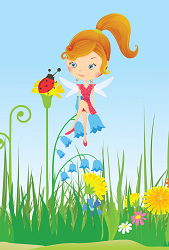Before reading a text, LOOK at its title, any pictures, and other text features.
SKIM over the first paragraph or two to get an idea of what the text is about.
Fiona, the Flower Fairy

, a lovely fairy named Fiona, lived in a meadow. She was friends with all the meadow creatures, who enjoyed her company and aimed to make her life in the meadow as pleasant as possible lest she leave. In the early evenings, the frogs and toads sang her to sleep in a chorus of peeps and ribbits and juggarumps. Similarly, the meadowlarks, bobwhites, and sparrows awoke her from her sleep early each morning and serenaded her throughout the day. But Fiona’s favorite of all the creatures in the meadow were the insects, like the lovely ladybugs and beautiful butterflies, who helped make the flowers of the meadow bloom.
Flower PowerFlowers are lovely to look at, and many of them smell wonderful, too. However, the true power of flowers lies in their ability to provide food and even medicine for people and animals.
About 80 percent of all plants are flowering plants, also called angiosperms. Angiosperms have systems of “roots and shoots.” The roots are usually underground. They anchor the plant and absorb water and nutrients from the soil. The shoots of a flowering plant include the stems, leaves, and flowers. The stems provide additional support, and they are the pathways for the nutrients and water to get to all the rest of the plant. Photosynthesis—the process by which plants make food from sunlight, carbon dioxide, and water—occurs in the leaves of the plant. The flowers of an angiosperm are where the seeds that allow for
reproduction are made. When seeds are made, the flowers form fruits around them to protect the seeds.
. . .
As you read, think about what you can
predict based on —
- Text features: pictures, titles, graphs, tables, diagrams, timelines, bold and italicized type, pronunciation guides.
- Type of text: informational article, poem, play, story, argumentative text.
- Text structure: cause-effect, problem-solution, compare-contrast, story plot, acts and scenes, rhyme schemes.
| Making predictions will help you understand what you read better. |
❋ ❋ ❋ ❋ ❋ ❋ ❋ ❋ ❋ ❋ ❋ ❋ ❋ ❋ ❋ ❋ ❋ ❋ ❋ ❋ ❋ ❋ ❋ ❋ ❋ ❋ ❋ ❋ ❋ ❋ | Go to the next page to practice making predictions about texts. |


 4th Grade Reading - Making Predictions Lesson
4th Grade Reading - Making Predictions Lesson







